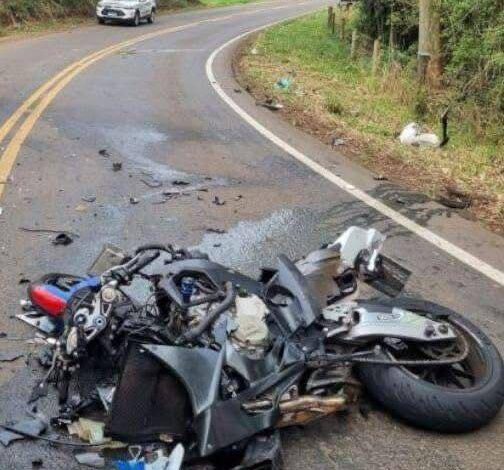
Tragic Motorcycle Crash on SC-390 Claims Life of 31-Year-Old
A tragic accident along the SC-390 highway in the municipality of Ipira, Santa Catarina, has left an entire community in mourning after a 31-year-old motorcyclist lost his life in a devastating collision on Saturday afternoon. The crash, which involved a high-performance BMW S1000 RR motorcycle and a Renault Sandero, has reignited serious concerns about road safety on one of Brazil’s most scenic yet notoriously dangerous highways.
According to official reports from the Military Highway Police (PMRv), the accident occurred on a curved section of the road. Witnesses and investigators say the motorcyclist, who was traveling at considerable speed, crossed into the opposite lane, directly into the path of the oncoming Sandero driven by a 30-year-old woman. The result was a violent head-on collision that left the motorcycle completely destroyed and the rider critically injured.
Emergency services, including firefighters and paramedics, responded quickly to the scene. Despite their efforts, the motorcyclist’s injuries were too severe. He was transported to a nearby hospital in critical condition but tragically passed away shortly after arrival. His name has not yet been released, as authorities are respecting the privacy of his family during this difficult time.
The driver of the Renault Sandero survived the crash without physical injuries. Police confirmed that she was subjected to a breathalyzer test, which returned negative results, ruling out alcohol as a contributing factor. However, the aftermath of the accident has raised new questions about how the crash scene was handled.
Authorities reported that the woman’s vehicle was removed from the site by family members before investigators could complete their assessment. This premature action has stirred controversy, as it may have interfered with the collection of crucial evidence needed to reconstruct the events accurately. Eyewitness photos circulating locally suggest the Sandero sustained significant damage to its front end, but the full extent cannot be officially confirmed because of the early removal.
What is beyond dispute, however, is the total destruction of the BMW motorcycle. The S1000 RR, valued between R$70,000 and R$150,000, was reduced to twisted metal and shattered fragments scattered across the roadway. Witnesses described the wreckage as “unrecognizable,” a chilling testament to the impact of the crash.
The Military Highway Police have launched a full investigation into the accident. Preliminary findings suggest that the motorcyclist’s lane crossing was the immediate cause of the collision, but other factors such as excessive speed and road conditions are also under review. The SC-390 highway, known for its breathtaking views and treacherous curves, has a long history of fatal accidents. Despite recent safety improvements, such as new signage and increased patrols, the road continues to challenge drivers and riders alike.
Local leaders and safety advocates are once again calling for stronger measures, including the installation of additional guardrails, stricter enforcement of speed limits, and public education campaigns to promote defensive driving. Many in Ipira believe that the tragedy underscores the urgent need for infrastructure upgrades and better awareness among motorists.
The death of the motorcyclist has left a deep emotional scar on the community. Friends and fellow riders remember him as a passionate motorcycling enthusiast who loved the freedom of the open road. Plans are already underway for a memorial ride in his honor, with local bikers coming together not only to pay tribute but also to advocate for greater safety measures.
Motorcycle accidents are a persistent issue in Brazil, where motorcycles remain one of the most common forms of transportation, particularly in rural and suburban areas. While they offer affordability and efficiency, they also come with disproportionately high risks. Experts cite several recurring problems: excessive speed, lack of protective gear, poorly maintained roads, and limited driver education about sharing the road safely with motorcycles.
Emergency response times can make the difference between life and death in such crashes. In this case, responders arrived promptly, but medical experts have stressed the need for expanded trauma facilities and possibly air ambulance services to cover remote stretches of dangerous highways like SC-390.
Eyewitness accounts further complicate the picture of what happened that Saturday. Several locals reported seeing the BMW traveling at high speed as it entered the curve where the accident occurred. Others pointed out that the weather conditions, though not rainy, were cloudy and somewhat dim, potentially affecting visibility. These details will form part of the ongoing investigation.
Beyond the technical aspects, there may also be legal implications. While initial evidence points to the motorcyclist being at fault for veering into the opposite lane, the early removal of the Sandero could raise questions in court. Legal experts suggest there may be civil liability and insurance disputes depending on the final findings of the investigation. If investigators cannot properly assess the car’s damage or position at the scene, it could complicate accountability.
For now, the crash serves as a sobering reminder to all road users of the importance of caution, patience, and adherence to traffic rules. Defensive driving, proper equipment like helmets and protective gear, and strict observance of speed limits are not optional—they are lifesaving measures. Routine maintenance of vehicles, particularly high-performance motorcycles, is also essential in preventing mechanical failures that can contribute to tragic outcomes.
The loss of the 31-year-old rider is a tragedy that could have been prevented, and it highlights the ongoing challenges of road safety in Santa Catarina and across Brazil. For his family, friends, and community, the pain is immeasurable. For policymakers and road users, it is yet another urgent call to action: safer roads, stricter enforcement, and a culture of responsibility must be priorities if such heartbreaking accidents are to be reduced.




